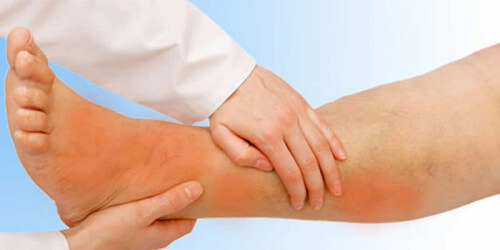arterial diseases
Peripheral arterial disease
what is a pad?
Peripheral artery disease (PAD) is a common circulation problem in which narrowed arteries reduce blood flow to your extremities.
When you develop peripheral artery disease (PAD), your limbs – usually the legs – don’t get enough blood flow. This causes symptoms, mostly pain in the legs when walking (claudication).
Peripheral artery disease is also likely to be a sign of atherosclerosis. This condition can reduce blood flow to your heart and brain, as well as to your legs.
You can often successfully treat peripheral artery disease by quitting tobacco, exercising and eating healthy.
when to see a doctor?
If you experience leg pain, numbness or other symptoms, don’t dismiss them as a normal part of aging. Call your doctor and make an appointment.
Even if you have no symptoms of peripheral artery disease, you may need to be screened if you are:
- Over 65 years of age;
- Over 50 years of age and have a history of diabetes or smoking;
- Under age 50 but have diabetes and other risk factors for peripheral artery disease, such as obesity or high blood pressure.

What are the symptoms?
While many people with peripheral artery disease have mild or no symptoms, some people have pain in the legs when walking (claudication).
Symptoms of claudication include muscle pain or cramps in the legs or arms that are triggered by activity, such as walking, but disappear after a few minutes of rest. The location of the pain depends on the location of the blocked or narrowed artery. Calf pain is the most common location.
The severity of claudication varies widely – from mild discomfort to debilitating pain. Severe claudication can make it difficult for you to walk or do other types of physical activity.
Signs and symptoms of peripheral artery disease include:
- Painful cramping in one or both of your legs after certain activities, such as walking or climbing stairs (claudication);
- Numbness or weakness of the legs;
- Coldness in the shin or foot, especially compared with the other limb;
- Sores on the toes, feet or legs that will not heal;
- Change in leg color;
- Shiny skin on the legs;
- No pulse or a weak pulse in your legs or feet;
- Erectile dysfunction in men.
If peripheral artery disease progresses, pain may occur even when you are at rest or when you lie down (ischemic pain at rest). It can be intense enough to disturb sleep. Lifting your legs over the edge of the bed or walking around your room can temporarily relieve the pain.
What are the reasons?
Peripheral artery disease is often caused by atherosclerosis. In atherosclerosis, fatty deposits (plaques) accumulate on the artery walls and reduce blood flow. Although discussions about atherosclerosis usually focus on the heart, the disease can and usually does affect arteries throughout your body. When it occurs in the arteries supplying blood to your extremities, it causes peripheral artery disease.
Less commonly, the cause of peripheral artery disease may be inflammation of the blood vessels, injury to the extremities, abnormal anatomy of your ligaments or muscles, or radiation exposure.
How to protect ourselves?
The best way to prevent claudication is to maintain a healthy lifestyle. This means:
- Quit smoking if you are a smoker.
- If you have diabetes, maintain your blood sugar level.
- Exercise regularly.
- Lower cholesterol and blood pressure levels if applicable.
- Eat foods low in saturated fat.
- Maintain a healthy weight.
Risk factors
Factors that increase the risk of developing peripheral artery disease include:
- Smoking;
- Diabetes;
- Obesity (body mass index over 30);
- High blood pressure;
- High cholesterol;
- Increasing age, especially after reaching the age of 50;
- Family history of peripheral artery disease, heart disease or stroke;
- High levels of homocysteine, a protein component that helps build and maintain tissue.
People who smoke or have diabetes have the greatest risk of developing peripheral artery disease (PAD) due to reduced blood flow.
Complications
If peripheral artery disease is caused by plaque buildup in the blood vessels (atherosclerosis), you are also at risk of developing it:
Critical limb ischemia. This condition begins as open wounds that do not heal, hurt or infect the feet or legs. Critical limb ischemia occurs when such injuries or infections progress and cause tissue death (gangrene), sometimes requiring amputation of the affected limb.
Stroke and heart attack. Atherosclerosis, which causes the signs and symptoms of peripheral artery disease, is not limited to your legs. Fat deposits also build up in arteries that supply blood to your heart and brain.
Diagnostics
Some of the tests used to diagnose Peripheral Artery Disease are:
Physical Examination. PAD can be detected during a physical examination, such as a weak or absent pulse under a narrowed section of your artery, rustling sounds over the arteries that can be heard with a stethoscope, evidence of poor wound healing in an area where your circulation is restricted, and decreased blood pressure in the affected limb.
Ankle-brachial index (ABI). This is a common test used to diagnose PAD. It compares the blood pressure in your ankle to the blood pressure in your arm.
You can walk on a treadmill and have readings taken before and immediately after exercise to capture the severity of narrowed arteries during walking.
Doppler sonography. Special ultrasound imaging techniques, such as Doppler ultrasound, can help assess blood flow through your blood vessels and identify blocked or narrowed arteries.
Angiography. Using contrast injected into the blood vessels, this test allows you to see how blood is flowing through your arteries. Imaging techniques such as X-ray imaging or procedures called magnetic resonance angiography (MRA) or computed tomographic angiography (CTA) may be used.
Catheter angiographyis a more invasive procedure that involves guiding a catheter through an artery in your groin to the affected area and injecting contrast. Although invasive, this type of angiography allows simultaneous diagnosis and treatment. After finding the narrowed area of a blood vessel, your doctor can then dilate it by inserting and expanding a tiny balloon or by administering medications that improve blood flow.
Blood tests. A sample of your blood can be used to measure cholesterol and triglycerides and to check for diabetes.

treatment
Treatment of peripheral artery disease has two main goals:
Reducing symptoms such as leg pain so you can resume physical activities.
Stop the progression of atherosclerosis throughout your body to reduce the risk of heart attack and stroke.
You may be able to achieve these goals with lifestyle changes, especially early in the course of peripheral arterial disease. If you smoke, quitting is the most important thing you can do to reduce your risk of complications.
If you have signs or symptoms of peripheral artery disease, you will probably need additional medication treatment.
In some cases, angioplasty or surgery may be needed to treat peripheral artery disease that causes claudication:
Angioplasty. In this procedure, a catheter is pushed through a blood vessel to the affected artery. There, a small balloon at the tip of the catheter inflates to reopen the artery and flattens the blockage in the artery wall, while stretching the artery to increase blood flow. Your doctor may also place a mesh frame called a stent in the artery to keep it open. This is the same procedure that doctors use to open heart arteries.
Thrombolytic therapy. If you have a blood clot blocking an artery, your doctor may inject a clot-dissolving medicine into your artery at the site of the clot to break it up.
In addition to your treatment, you will be prescribed a controlled exercise program to increase the distance you can travel without pain. Regular exercise improves symptoms of PAH in many ways, including helping the body use oxygen more efficiently.
